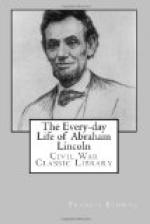THOMAS LINCOLN
FATHER OF
THE MARTYRED PRESIDENT.
BORN
JAN. 6th, 1778
DIED
JAN. 15th, 1851.
LINCOLN.
“And now,” concluded Mr. Balch, “I have given all that can be known of Thomas Lincoln. I have written impartially and with a strict regard to facts which can be substantiated by many of the old settlers in this county. Thomas Lincoln was a harmless and honest man. Beyond this, one will search in vain for any ancestral clue to the greatness of Abraham Lincoln.”
After reaching the new home in Illinois, young Lincoln worked with his father until things were in shape for comfortable living. He helped to build the log cabin, break up the new land and fence it in, splitting the rails with his own hands. It was these very rails over which so much sentiment was expended years afterward at an important epoch in Lincoln’s political career. During the sitting of the State Convention at Decatur, a banner attached to two of these rails and bearing an appropriate inscription was brought into the assemblage and formally presented to that body amid a scene of unparalleled enthusiasm. After that they were in demand in every State of the Union in which free labor was honored. They were borne in processions by the people, and hailed by hundreds of thousands as a symbol of triumph and a glorious vindication of freedom and of the right and dignity of labor. These, however, were not the first rails made by Lincoln. He was a practiced hand at the business. As a memento of his pioneer accomplishment he preserved in later years a cane made from a rail which he had split on his father’s farm.
The next important record of Lincoln’s career connects him with Mr. Denton Offutt. The circumstances which brought him into this relation are thus narrated by Mr. J.H. Barrett: “While there was snow on the ground, at the close of the year 1830, or early in 1831, a man came to that part of Macon County where young Lincoln was living, in pursuit of hands to aid him in a flatboat voyage down the Mississippi. The fact was known that the youth had once made such a trip, and his services were sought for this occasion. As one who had his own subsistence to earn, with no capital but his hands, he accepted the proposition made him. Perhaps there was something of his inherited and acquired fondness for exciting adventure impelling him to this decision. With him were also employed his former fellow-laborer, John Hanks, and a son of his step-mother named John Johnston.




